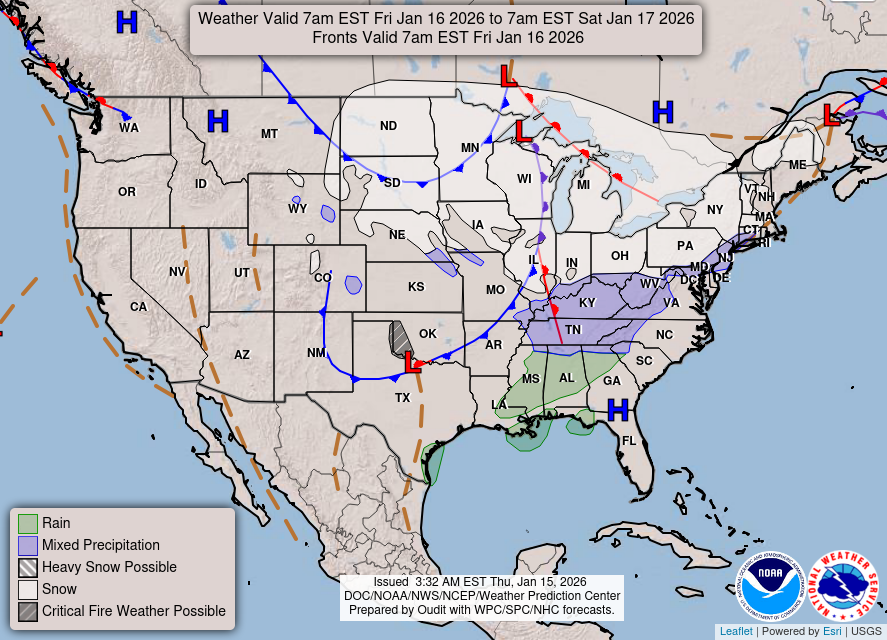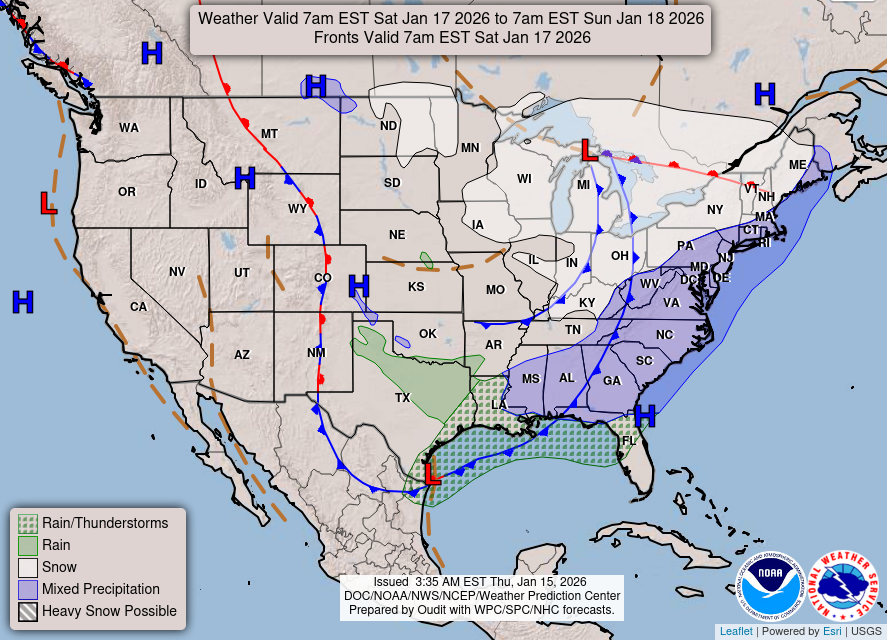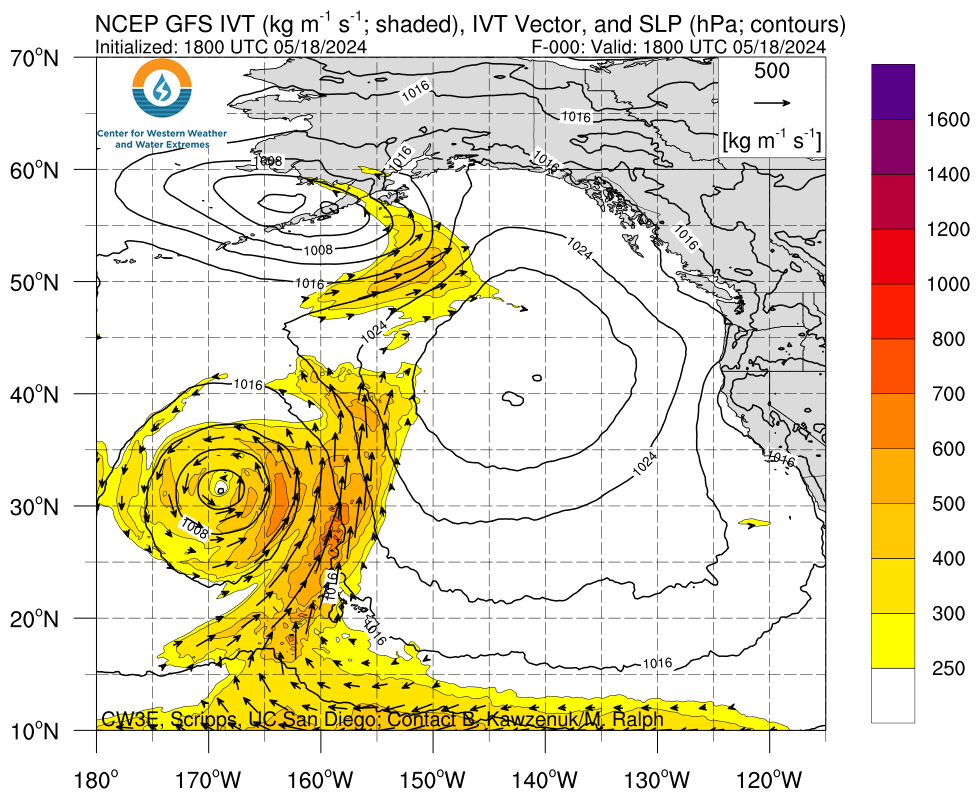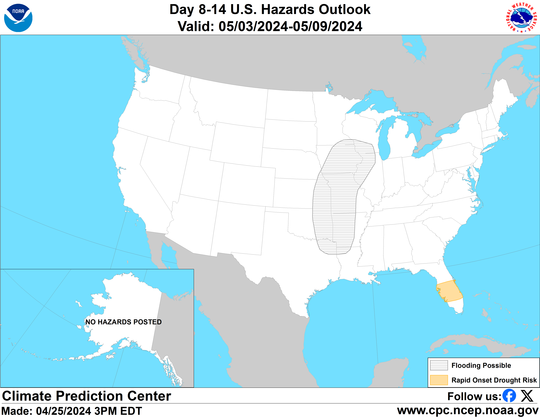This article focuses on what we are paying attention to in the next 48 to 72 hours. The article also includes weather maps for longer-term U.S. outlooks (up to four weeks) and a six-day World weather outlook which can be very useful for travelers.
First the NWS Short Range Forecast. The afternoon NWS text update can be found here after about 4 p.m. New York time but it is unlikely to have changed very much from the morning update. The images in this article automatically update.
Short Range Forecast Discussion
NWS Weather Prediction Center College Park MD
400 AM EDT Sun Oct 06 2024
Valid 12Z Sun Oct 06 2024 – 12Z Tue Oct 08 2024…Tropical Storm Milton continues to intensify over the southwest Gulf of
Mexico and is expected to move northeastward towards the Florida Gulf
Coast……Very heavy rainfall well ahead of Tropical Storm Milton will arrive
across the Florida Peninsula and Keys bringing the threat of flash
flooding……Showers and thunderstorms expected for portions of the interior
Northeast Sunday with the threat for some large hail and damaging winds……Record-breaking heat will continue across California and the Southwest
through the remainder of the weekend and into early next week…Tropical Storm Milton continues to intensify in the southwestern Gulf of
Mexico and is currently forecast by the National Hurricane Center (NHC) to
move northeastward towards the Gulf Coast of Florida, with a possible
landfall on Wednesday. However, potentially significant flooding impacts
are expected well ahead of the storm as anomalously moist tropical air and
instability increase south of a wavy frontal boundary draped across the
Florida Peninsula. There is now a Moderate Risk of Excessive Rainfall
(level 3/4) Sunday over South Florida for a more concentrated corridor of
thunderstorms producing intense downpours with totals that could exceed
5″. This will bring a more significant risk of scattered to numerous
instances of flash flooding in urban areas. A Slight Risk (level 2/4)
extends north along the Atlantic Coast and also west along the Gulf Coast
through the central Peninsula for additional scattered instances of flash
flooding. Another Slight Risk on Monday covers the Atlantic Coast of the
central Peninsula as well as the southwestern Gulf Coast and South Florida
as the threat for thunderstorms with very heavy rainfall and flash
flooding continues. Follow the latest forecast from the NHC for updated
information on the expected track and potential impacts mid-week.An upper-level wave/surface frontal system will pass through areas of the
interior Northeast including the Appalachians, Lower Great Lakes, and the
Upper Ohio Valley Sunday bringing scattered showers and thunderstorms.
Sufficient instability ahead of the front as well as strong flow at the
low and mid-levels may lead to some more robust, severe thunderstorms. The
Storm Prediction Center (SPC) has highlighted western New York and
Pennsylvania as well as eastern Ohio and the northern Panhandle of West
Virginia with a Slight Risk (level 2/5) of severe weather mainly for the
threat of large hail and damaging winds. The SPC has also noted that gusty
winds and dry conditions behind a trailing cold front extending to the
southwest through the Midwest and into the central Plains will lead to an
Elevated Risk of fire weather. As the system continues eastward, showers
and thunderstorms will spread into the northern Mid-Atlantic late
Sunday/early Monday and into New England during the day Monday. Most of
the rest of the country will be without precipitation chances the next
couple of days expect the Pacific Northwest where rain chances will pick
up by later Monday ahead of a Pacific system.A record-breaking late-season heat wave continues this weekend and into
early next week across central and southern California and the Desert
Southwest as a ridge of high pressure aloft persists over the region.
Forecast highs continue to soar into the upper 90s to low 100s outside of
the immediate coastal areas of central and southern California, with high
temperatures reaching as high as the low 110s for the interior portions of
the Desert Southwest. Numerous daily record-tying or record-breaking high
temperatures are expected to occur across the region going through Monday.
Heat-related advisories and warnings are in place as this persistent level
of major to extreme heat remains a danger to anyone without adequate
air-conditioning or hydration, and for those spending greater time
outdoors. While not quite as hot, highs will trend above average again for
most of the rest of the Intermountain West as well, with highs in the 70s
and low 80s for the northern Great Basin/Rockies and into the mid-80s for
the central Great Basin. These very warm temperatures will also spread
east out into the northern/central Plains early next week. In fact, by
Monday and Tuesday, some areas of the northern Plains are expected to see
high temperatures upwards of 20 degrees above average, reaching as high as
the upper 70s and low 80s. Much of the Ohio/Tennessee Valleys and
Mid-South/Lower Mississippi Valley will see unseasonably warm temperatures
well into the 80s on Sunday. A cold front passage will bring much cooler,
more seasonable temperatures to the Great Lakes/Ohio Valley Monday as
highs only top out in the 60s, with 70s into the Tennessee Valley and
Mid-South. Further south, hot temperatures will also continue for portions
of the southern Plains and Texas, with daily highs remaining in the upper
80s to mid-90s.
To get your local forecast plus active alerts and warnings click HERE and enter your city, state or zip code.
Learn about wave patterns HERE.
Then, looking at the world and of course, the U.S. shows here also. Today we are looking at precipitation.
Please click on “Read More” below to access the full Daily Report issued today.
| Notices: What would you like to learn about? Please provide that to me via the comment section at the end of the article. |
Now more detail on the 48-Hour Forecast (It is a 48 to 72 Hour Forecast actually)
Daily weather maps. The Day 1 map updates twice a day and the Day 2 and 3 maps update only once a day. These maps update automatically. But if that does not happen, you can get updates by clicking HERE
TODAY (or late in the day the evening/overnight map will appear) (Key to surface fronts shown on maps and you will then also be able to insert a city name or zip code and get a local NWS forecast).

TOMORROW

NEXT DAY

We have a new animation of the forecast which shows how things may play out over the next 60 hours. To update click ANIMATION. Doing so will get you to the dashboard. You can then step through the animation or hit LOOP on the upper right of the display. You will have to hit the back arrow ← at the top left on your computer to get back into this article. It is a little more trouble than before but I think NOAA scrapped the animation routine I was using so we have to keep up with “progress”.
The NWS Climate Prediction Center’s: Watches, Warnings, and Advisories plus other information can be found HERE. That takes you to the NWC Severe Weather Site. From there you can select among many categories of information. Remember to hit the back arrow ← at the top left of your screen to return to this article.
ATMOSPHERIC RIVERS
This tells us what is approaching the West Coast. Click HERE to update If I have not gotten around to doing the update. Here is some useful information about Atmospheric Rivers.
Below is the current five-day cumulative forecast of precipitation (Updates can be found HERE)

Ski SnowReports will Resume in the Fall.
Now we look at Intermediate-Term “Outlook” maps for three time periods. Days 6 – 10, Days 8 – 14, and Weeks 3 and 4. An outlook differs from a forecast based on how NOAA uses these terms in that an “outlook” presents information as deviation from normal and the likelihood of these deviations.
Below are the links to obtain updates and additional information. They are particularly useful if you happen to be reading this article significantly later than when it was published. I always try to provide readers with the source of the information in my articles. These links may also be useful for those viewing this article on a cell phone or other small screen.
| Days 6 – 10 (shown in Row 1) | Days 8 – 14 (Shown in Row 2) | Weeks 3 and 4 (Shown in Row 3 but updates only on Fridays) |
| https://www.cpc.ncep.noaa. gov/products/predictions/610day/ | https://www.cpc.ncep .noaa.gov/products/predictions/814day/ | https://www.cpc.ncep.noaa.gov/products/predictions/WK34/ |
Showing the actual maps. They should now update automatically. The Week 3 – 4 Outlook only updates on Fridays. So below is what I call the Intermediate-term outlook. On Fridays, it extends out 28 Days. That declines day by day so on Thursday it only looks out 22 days until the next day when the Week 3 – 4 Outlook is updated and this extends the outlook by one additional week.
| 6–
10
|
|
|
| 8–
14 |
|
|
| 3–
4 |
|
|
HAZARDS OUTLOOKS
Click here for the latest complete Day 3 -7 Hazards forecast which updates only on weekdays. Once a week probably Monday or Tuesday I will update the images. I provided the link for readers to get daily updates on weekdays. Use your own judgment to decide if you need to update these images. I update almost all the images Friday Night for the weekend edition of this Weather Report. So normally readers do not need to update these images but if the weather is changing quickly you may want to.

Temperature month to date can be found at https://hprcc.unl.edu/products/maps/acis/MonthTDeptUS.png
Precipitation month to date can be found at https://hprcc.unl.edu/products/maps/acis /MonthPNormUS.png
World Forecast [that website is has been intermittent so be patient]
Below are the Day 1 -3 and 4-6 forecasts for temperature and precipitation. Updates and much additional information can be obtained HERE
World Temperature Anomalies


World Accumulated Precipitation


This information is provided by the University of Maine. They draw upon many different sources. There is a lot of information available at the link provided. I have just provided two useful forecasts. There are probably over a hundred different forecasts available from this source.
Worldwide Tropical Forecast (This is a NOAA Product)
This graphic updates on Tuesdays) If it has not been updated, you can get the update by clicking here Readers will only have to do that if they are reading this article much later than the date of it being published.
Information on Tropical Storms can be found HERE. Western Pacific information can be found HERE. Note that unless there is an out-of-season storm the below images will not update until the National Hurricane Center starts their seasonal update of these maps on June 1. I include them simply because there can be an out-of-season event in which case it should show up in these maps.


–
| I hope you found this article interesting and useful. |










